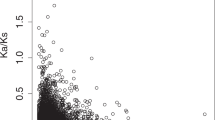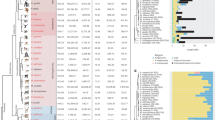Abstract
IT is now well established that in the somatic cells of mammals only a single X chromosome is active in coding for proteins, no matter how many are present1,2, but the mechanism and evolutionary origin of this phenomenon still remain unsolved problems. Cooper3 suggested that the random inactivation of X chromosomes derived from either parent in eutherian mammals had evolved from a more primitive inactivation of the paternally derived X chromosome as seen in marsupials, and a possible mechanism for this evolution has been put forward4. Lifschytz and Lindsley5 further suggested that the inactivation seen in somatic cells had evolved from inactivation of both sex chromosomes in male gametogenesis, a phenomenon that is general in gametes of the heterogametic sex of many species.
This is a preview of subscription content, access via your institution
Access options
Subscribe to this journal
Receive 51 print issues and online access
$199.00 per year
only $3.90 per issue
Buy this article
- Purchase on Springer Link
- Instant access to full article PDF
Prices may be subject to local taxes which are calculated during checkout
Similar content being viewed by others
References
Lyon, M. F., Nature, 190, 372–373 (1961).
Lyon, M. F., Biol. Rev., 47, 1–35 (1972).
Cooper, D. W., Nature, 231, 292–294 (1971).
Brown, S. W., and Chandra, H. S., Proc. natn. Acad. Sci. U.S.A., 70, 195–199 (1973).
Lifschytz, E., and Lindsley, D. L., Proc. natn. Acad. Sci. U.S.A., 69, 182–186 (1972).
Epstein, C. J., Science, 163, 1078 (1969).
Epstein, C. J., Science, 175, 1467–1468 (1972).
Gartler, S. M., Liskay, R. M., Campbell, B. K., Sparkes, R., and Gant, N., Cell Differ., 1, 215–218 (1972).
Hamerton, J. L., Nature, 219, 910–914 (1968).
Lyon, M. F., and Hawker, S. G., Genet. Res., 21, 185–194 (1973).
Cattanach, B. M., Pollard, C. E., and Hawkes, S. G., Cytogenetics, 10, 318–337 (1971).
Lyon, M. F., in Reproductive Physiology and Genetics (edit. by Fuchs, F., and Coutinho, E. M.) (Plenum, New York, in the press).
Welshons, W. J., and Russell, L. B., Proc. natn. Acad. Sci. U.S.A., 45 560–566 (1959).
Ohno, S., Nature, 234, 134–137 (1971).
Lyon, M. F., and Hawkes, S. G., Nature, 227, 1217–1219 (1970).
Ohno, S., Sex Chromosomes and Sex-linked Genes (Springer, Berlin, 1967).
Cattanach, B. M., and Moseley, H., Cytogenet. Cell Genet., 12, 264 (1973).
Ducos, J., Marty, Y., Sanger, R., and Race, R. R., Lancet, ii, 219–220 (1971).
Ferguson-Smith, M. A., J. med. Genet., 2, 93–156 (1965).
Penrose, L. S., Lancet, i, 298–300 (1967).
Nes, N., Forskning og forsok i Landbruket, 19, 393–440 (1968).
Weiss, G., Weick, R. F., Knobil, E., Wolman, S. R., and Gorstein, F., Folia Primat., 19, 24–27 (1973).
Norby, D. E., Hegreberg, G. A., Thuline, H. C., and Findley, D., Cytogenet. Cell Genet. (in the press).
Yong, H. S., Nature, 232, 484–485 (1971).
Bianchi, N. O., and Contreras, J. R., Cytogenetics, 6, 306–313 (1967).
Ohno, S., in Second International Conference on Congenital Malformations, 40–42 (International Medical Congress, New York, 1963).
McKusick, V. A., O. Rev. Biol., 37, 69–175 (1962).
Race, R. R., and Sanger, R., Blood Groups in Man (Blackwell, Oxford, 1968).
McKusick, V. A., Mendelian Inheritance in Man (Johns Hopkins Press, Baltimore. 1971).
Mouse News Lett., 49, (1973).
Author information
Authors and Affiliations
Rights and permissions
About this article
Cite this article
LYON, M. Evolution of X-chromosome inactivation in mammals. Nature 250, 651–653 (1974). https://doi.org/10.1038/250651a0
Received:
Issue Date:
DOI: https://doi.org/10.1038/250651a0
This article is cited by
-
Anderson-Fabry disease in Austria
Wiener Klinische Wochenschrift (2003)
-
A proposed path by which genes common to mammalian X and Y chromosomes evolve to become X inactivated
Nature (1998)
-
Expression of the X–inactivation–associated gene XIST during spermatogenesis
Nature Genetics (1992)
-
The evolution of the mammalian Y chromosome
Behavior Genetics (1990)
-
Post-meiotic transcription of phosphoglycerate-kinase 2 in mouse testes
Bioscience Reports (1985)
Comments
By submitting a comment you agree to abide by our Terms and Community Guidelines. If you find something abusive or that does not comply with our terms or guidelines please flag it as inappropriate.



